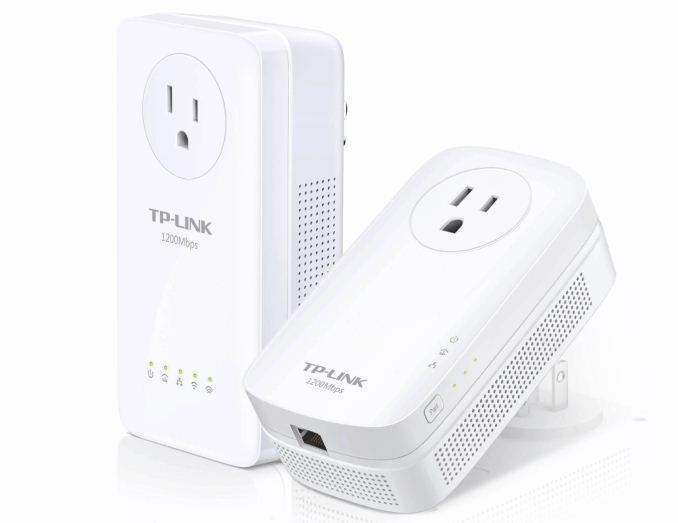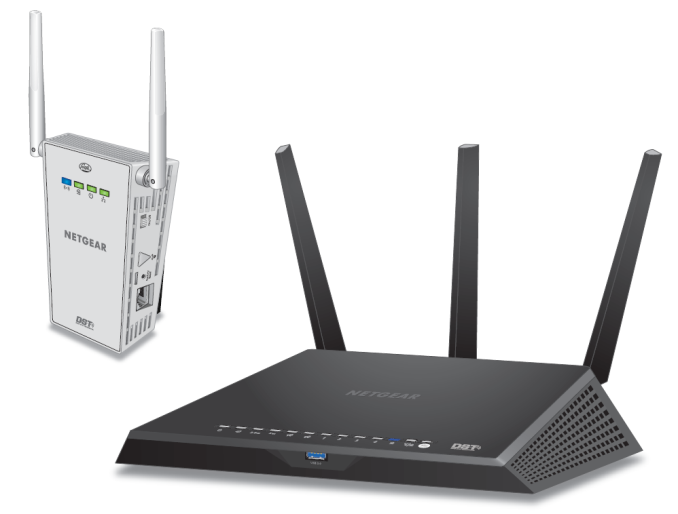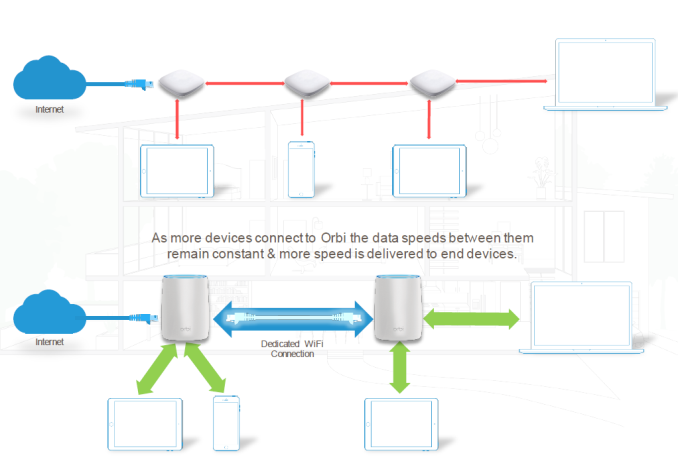Extending Home Networks - A Comparison of G.hn, HomePlug AV2 and Wi-Fi Mesh
by Ganesh T S on December 7, 2016 8:00 AM EST
Over the last decade or so, we have seen a rapid increase in the number of devices connecting to the home network. The popularity of IoT has meant that even devices that are not mobile require communication over the Internet, but, their placement might be far away from the primary router in the house. Given this situation, it is essential to find a reliable way to extend the reach of the home network. There have been many attempts to come up with a standardized way to do it, but consumers have been forced to use range extenders, powerline networking kits and the like to increase the reach of their home networks.
Given the multitude of available options to extend the reach of home networks, what underlying technology should consumers look for? Today's article provides a comprehensive overview of the available options as well as a quantitative comparison in one particular residential scenario - a 1800 sq. ft. single-level California house built in the 1970s.
Introduction
A discussion of the various ways to extend home networks must always be prefaced with a simple suggestion - if it is at all possible to wire up the major rooms in the house with Cat 6 cables, the reader should definitely go for it. Wi-Fi access can then be made available in remote locations with the use of access points that piggy-back on the Cat 6 backbone. This article tackles situations where wiring up the residence with Cat 6 cables is not a practical option.
Most residences have some sort of wired infrastructure going around - everyone has electrical wiring that is bound to be in every room. Some have telephone wires already present, while others have a coax cable network. In order to expand the reach of home networks, there are ways to use all of the above media. In addition to wired backhauls based on these, Wi-Fi itself can be used for this 'last feet' data transfer. Encompassing all these is the concept of hybrid networking - i.e., a way to get communication over different media to work together seamlessly in order to extend the network reach.
The industry recognized the need for hybrid networking around 5 years back and set up the IEEE P1905 working group. The approach, mainly spearheaded by Qualcomm Atheros, involved usage of HomePlug powerline chipsets as well as MoCA (Multimedia-over-Coax Alliance) chipsets in Wi-Fi routers to ensure a seamless connected digital home. However, the added price for the functionality led to the vendors largely giving this endeavor a miss. As of 2016, there are no known hybrid networking packages in the market. That said, there are many vendors who have range extenders that use a powerline backhaul (such as the TP-LINK AC1200 Wi-Fi Range Extender AV1200 Powerline Edition). Even though these products fulfill the basic requirement of extending the home network, they are not marketed as a unified solution with a primary router.
Netgear does have the Nighthawk DST (Dead Spot Terminator) kit hat combines a Nighthawk R7000 with a Broadcom-based HomePlug AV2-compliant PLC chipset. However, it is more of a limited release with the kit being sold only through Best Buy.
ITU's G.hn (G.9960) specification for home networks has been of interest due to its ability to operate over different media (telephone wiring, coax cables, and power lines). The technology had only been on paper for a long time, but, in early 2015, we saw some powerline networking products based on G.hn appear in the retail market. Marvell Semiconductors is a big proponent of G.hn. The current G.hn powerline adapters in the market are all based on their chipsets. Recognizing the need for hybrid networking, ARRIS has made an attempt to integrate proven 802.11ac Wi-Fi solutions with Marvell's G.hn platform. The resulting product portfolio has enabled consumers to seamlessly extend the reach of their home networks. Marketed under the RipCurrent moniker, these products include a primary Wi-Fi router and optional powerline extenders as well as a Wi-Fi range extender with a powerline backhaul. They target homes that end up with Wi-Fi dead spots when a single router is deployed.
Mesh Wi-Fi has emerged as one of the interesting approaches to residential Wi-Fi over the last 12 - 18 months. Even though it is being marketed as something revolutionary, the concepts have been around for a long time. In fact, Wi-Fi range extenders operate on almost the same principles, but, mesh Wi-Fi systems adopt a few strategies to make users think that they have a magical solution:
- By selling units in packs of 3, they guarantee that a vast majority of the homes can be completely blanketed with Wi-Fi
- By adopting an attractive industrial design, they ensure that users don't need to keep the networking equipment hidden away. This helps in minimizing the attenuation of the Wi-Fi signals
- The setup process and user experience are no longer bound by the traditional router configuration / usage interfaces. In a mobile-first world where the majority of the consumers prefer their experience to be dumbed down, many of the mesh Wi-Fi vendors have an app-based setup process and monitoring that focuses on basics and disregards advanced features. The ease of use has translated to popularity amongst consumers who are not tech-savvy.
The basic operation models for wireless range extenders and mesh Wi-Fi router units are similar. Some mesh systems such as the Netgear Orbi use a separate channel for the backhaul (communication between the member units). This ensures that there is no airtime wasted when there are active wireless clients.
Mesh Wi-Fi systems can either adopt a 'spokes' model, with a primary router and the satellites talking directly to it, or, a 'real mesh' model where a node can have one or more hops to reach the primary router. The effectiveness of either approach is dependent on the location of the primary router relative to the dead spots in the house, as well as the number of member nodes.
Most mesh Wi-Fi systems currently in the market are based on Qulacomm's Wi-Fi Self-Organizing-Networks (SON) solution. A detailed perusal of the technology makes it evident that it is the brains behind the marketing cloak of mesh Wi-Fi systems from Netgear, Google, Luma and eero.
Readers now have a broad understanding of the various options available to extend the reach of home networks. In the next section, we will take a look at the various kits that were evaluated and the approach under which each of them falls. The evaluation methodology is also spelt out in detail. A couple of sections looking at the performance numbers is followed by some concluding remarks.














56 Comments
View All Comments
nedjinski - Wednesday, December 7, 2016 - link
Is Google's recently announced Wi-Fi / OnHub too late to be included in this article? Or is a different type of system?nedjinski - Wednesday, December 7, 2016 - link
http://www.theverge.com/2016/12/6/13843536/google-...J_D - Wednesday, December 7, 2016 - link
http://arstechnica.com/gadgets/2016/12/review-comp...Meteor2 - Tuesday, December 13, 2016 - link
Thanks for those links; good reviews. Orbi boasts best performance, but Google WiFi clearly wins with good design and user experience, and adequate performance.Sailor23M - Saturday, December 10, 2016 - link
Problem with getting a google system is that I suspect that it will "phone home" on everything I do on the internet.iamlilysdad - Wednesday, December 7, 2016 - link
The benchmarks processed for this article were aimed at determining the effectiveness of kits in extending the reach of the home networks. Therefore, it was an evaluation of the backhaul, rather than performance with client devices themselves.^^^ Is there an upcoming article that addresses real world performance and use for client devices? Seems that is ultimately what needs to be measured since that is the entire user experience. I don't care about backhaul capability if the device fails to provide adequate performance to the devices that I connect to it.
melgross - Wednesday, December 7, 2016 - link
This is all very nice, but that house is very easy to do. Older houses are much more difficult.My house was built in 1925. It's two floors. The ceilings are wood lath, with steel mesh holding 3/4 inch mortar with 1/4 inch plaster with numerous layers of paint, the older layers are lead based (well contained). The walls are mostly brick with the above lath, etc. This is very difficult.
While most of the house was wired by myself years ago with CAT 5e, there's a problem. For some reason, my FIOS router doesn't allow (though the instructions says it does, word out is that it's buggy) multiple Ethernet connections for the extenders, for wifi, though Ethernet works just fine, even when I do exactly what the manual says to do. So I tried to use the extenders through my main Apple router, but no go. More than one wifi router wired directly, or through the main apple unit turn the internet signal off at the gateway. Weird! This all worked perfectly with the old gateway with COVAD, so I don't think it's anything I'm doing wrongly.
Because of this, I'm forced to use 4 Apple routers around the house, and I get 155/155 near the main router and with the one in the living room, but then it falls to 30/30, and even lower to below 20/20. Since FIOS is 150/150, or a bit higher, it's frustrating.
So the question here is not how well these do in cheaply built 70's bousing, but in older housing that much less easy for signal throughput. We really need these things tested under more serious conditions.
BrokenCrayons - Wednesday, December 7, 2016 - link
Your home situation sort of started me thinking. One older home I lived in had a wood burning stove as its primary heat source. It was part of the original design, but an oil burning forced air furnace was later added. In any event, in the original design, several grated holes were placed in the ceiling of the first floor to ensure heat from the stove would reach the second floor.You could do something similar with your home by cutting open the floors and the walls to install wireless friendly passages that help signals travel more freely. If I was on anything faster than a 12mbps down and 768kbps up DSL link, I'd seriously consider doing the same because there's nothing worse than having a downstream connection that's faster than your local network. A few window-sized holes in the right walls and floors could vastly improve your situation.
melgross - Wednesday, December 7, 2016 - link
Yes. That's very funny. Cutting windows sized holes throughout the house would add to air flow as well.BrokenCrayons - Thursday, December 8, 2016 - link
I'm not suggesting you just grab some tools and start chopping. To retain house value, you probably should ensure the job is done professionally and the holes are dressed to look appealing to the eye. In my mind, fast network access is worth the trouble of doing some modifications. Besides, the wireless-friendly nature of your home after modifications are completed will probably drive up its resale value to potential buyers that are upset about the same problems your're experiencing now.The other alternative, depending on your financial situation, is just to unload that house on the market and move into newer construction that can handle modern needs. Though older homes have a certain rustic and quaint appeal, we really should be demolishing buildings made before lead regulations were put in place to get rid of those unsightly old structures. Modern houses are a lot more energy efficient anyway and it's really irresponsible for us to keep anything that was built before the 1990s up and working. Such places are ultimatly wasteful and unfit for human habitation due to a variety of health hazards introduced during their construction.